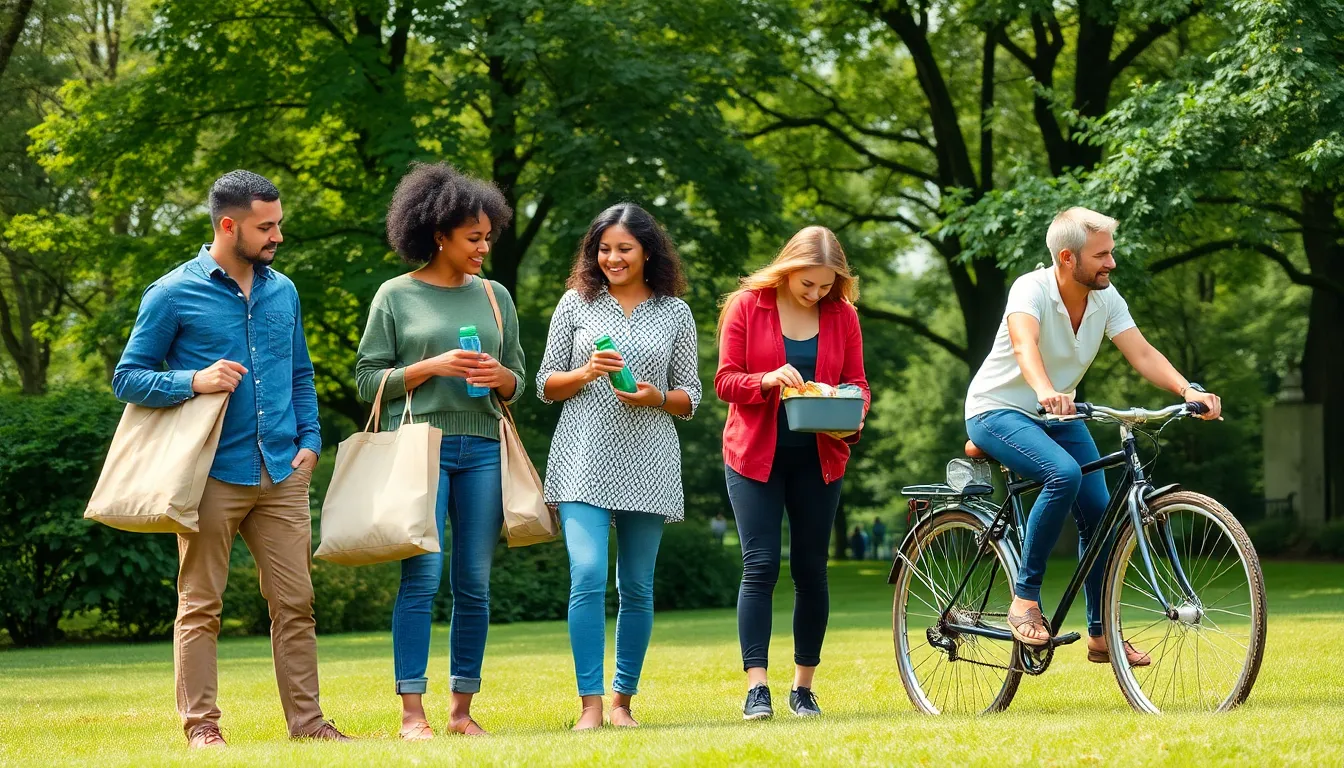Table of Contents
ToggleIn a world where plastic straws seem to have more followers than some celebrities, sustainable living is the new black. It’s not just a trend; it’s a lifestyle choice that can save the planet—one reusable shopping bag at a time. Imagine a life where your morning coffee doesn’t come with a side of guilt and your carbon footprint doesn’t resemble a T-Rex.
Sustainable living isn’t about going off the grid and wearing hemp sandals (unless that’s your thing). It’s about making smarter choices that benefit both you and Mother Earth. From energy-efficient appliances to zero-waste practices, every little step counts. So why not dive into the world of sustainability? After all, saving the planet can be just as rewarding as binge-watching your favorite series—without the guilt of a popcorn binge.
Understanding Sustainable Living
Sustainable living combines environmental awareness and responsible choices. Individuals adopt practices that minimize ecological impact and promote resource conservation.
Definition and Principles
Sustainable living refers to lifestyle choices that promote ecological balance and resource conservation. This approach focuses on reducing waste, conserving energy, and utilizing renewable resources. Key principles include minimizing carbon footprints, supporting local economies, and practicing mindful consumption. By prioritizing sustainability, individuals contribute to a healthier planet for future generations.
Importance in Today’s World
The importance of sustainable living grows in light of climate change, resource depletion, and environmental degradation. Current data indicates that human activities significantly contribute to greenhouse gas emissions, making lifestyle changes essential for mitigating these effects. Sustainable practices foster resilience within communities and promote social equity. By adopting sustainable habits, individuals play a crucial role in protecting the environment and ensuring a sustainable future.
Key Practices of Sustainable Living

Sustainable living encourages individuals to adopt specific practices that minimize environmental impact. These practices vary but can significantly contribute to a healthier planet.
Reducing Waste
Reducing waste involves minimizing the amount of trash generated. Individuals can achieve this by opting for reusable products such as water bottles, shopping bags, and containers. Composting organic waste transforms food scraps into nutrient-rich soil, significantly reducing landfill contributions. Purchasing items with minimal packaging also helps, leading to less plastic consumption. The concept of “buying less” inspires consumers to avoid unnecessary purchases and reduce overall waste.
Energy Efficiency
Energy efficiency focuses on using less energy to perform the same tasks. Upgrading to LED light bulbs decreases energy consumption and lasts significantly longer than traditional bulbs. Employing energy-efficient appliances contributes to lower utility bills and reduced greenhouse gas emissions. Incorporating smart home technology optimizes energy use by adjusting settings based on individual habits. Simple actions, like unplugging devices when not in use, further enhance energy savings.
Sustainable Transportation
Sustainable transportation emphasizes reducing the carbon footprint associated with travel. Utilizing public transportation or carpooling decreases the number of vehicles on the road, which in turn lowers emissions. Biking and walking not only benefit the environment but also promote personal health. Hybrid and electric vehicles offer a cleaner alternative to traditional gasoline-powered cars. Making conscious choices about travel encourages individuals to consider the environmental impact of their daily commutes.
Benefits of Sustainable Living
Sustainable living offers numerous benefits, impacting the environment, health, and economy in positive ways. Adopting this lifestyle leads to significant advantages for individuals and communities.
Environmental Impact
Sustainable living practices effectively reduce waste and lessen pollution. Utilizing renewable resources, such as solar energy, diminishes dependence on fossil fuels. Choosing local produce supports lower carbon emissions from transportation. Making conscious decisions about consumption conserves natural resources and fosters biodiversity. Communities engaging in sustainable practices create healthier ecosystems and contribute to climate change mitigation efforts.
Health and Well-being
Health outcomes improve through sustainable living practices. Consuming organic and locally-sourced foods often leads to better nutrition and fewer chemical exposures. Engaging in outdoor activities, such as hiking and gardening, promotes physical fitness and mental well-being. Sustainable living often reduces stress through connection to nature. Communities dedicated to sustainability enhance social interactions, fostering strong relationships and support networks.
Economic Advantages
Sustainable choices lead to financial savings and economic growth. Energy-efficient appliances cut utility costs, providing immediate savings to households. Investing in renewable energy technologies can create new jobs and stimulate local economies. Supporting local businesses boosts community resilience and helps circulate money within the area. Overall, sustainable living practices can lead to long-term financial stability for individuals and communities alike.
Challenges to Sustainable Living
Various challenges impede the pursuit of sustainable living. Addressing these obstacles requires awareness and action.
Overcoming Barriers
Barriers to sustainable living often stem from habit, convenience, and access. Many individuals find it difficult to shift from familiar routines to sustainable alternatives. Limited access to resources, such as public transport or organic products, can hinder adoption. Cost can also play a significant role; sustainable options sometimes appear more expensive upfront, discouraging commitment. Education remains vital; understanding the long-term benefits can motivate individuals to make changes. Encouraging community initiatives offers support through shared resources and knowledge. Building infrastructure that promotes sustainable choices can simplify the transition.
Misconceptions
Misconceptions about sustainable living frequently create misconceptions and resistance. Some believe it requires drastic life changes, making it seem like an overwhelming challenge. Others assume sustainable products are less effective or inferior in quality; however, many achieve equal or superior performance. Additionally, the notion that only affluent individuals can practice sustainability deters many from participating. In reality, small, consistent changes cumulatively yield significant impact. Developing clarity around sustainable living can empower individuals; education helps dispel myths and promotes inclusive participation.
Embracing sustainable living is a vital step towards creating a healthier planet and fostering resilient communities. By making conscious choices and adopting eco-friendly practices, individuals can significantly reduce their environmental impact while enjoying the benefits of improved health and financial savings.
Sustainable living isn’t just about big changes; it’s about the small, everyday actions that collectively make a difference. As more people recognize the importance of their choices, the movement towards sustainability will continue to gain momentum.
Together, these efforts can lead to a brighter future for generations to come, where both people and the planet thrive in harmony.




